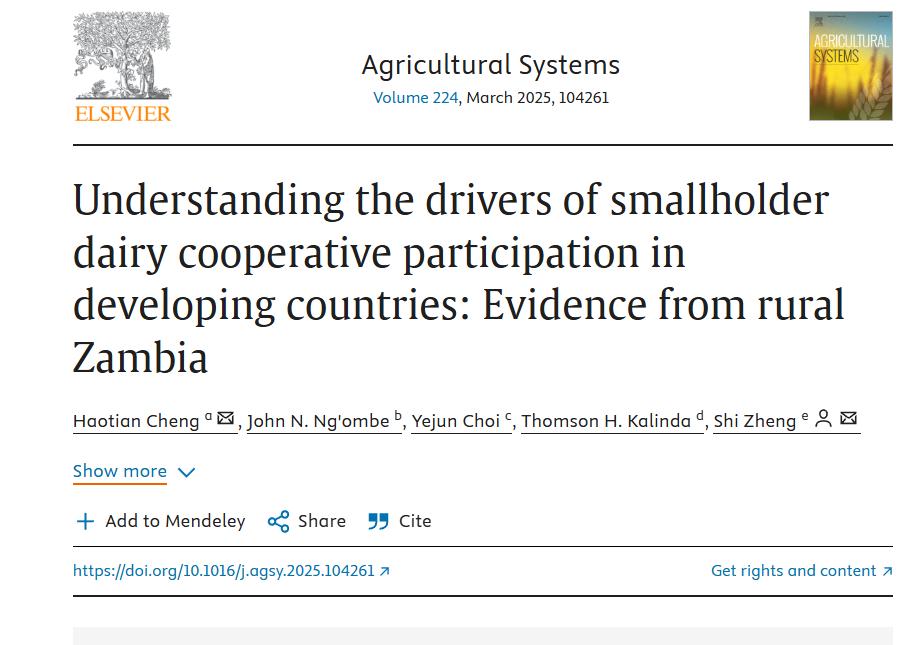近日,我院程昊天副教授及美国北卡农工州立大学John N. Ng'ombe助理教授、韩国釜山国立大学Yejun Choi助理教授、赞比亚大学Thomson H. Kalinda教授、中国人民大学郑适教授合作论文“Understanding the drivers of smallholder dairy cooperative participation in developing countries: Evidence from rural Zambia”在期刊Agricultural Systems在线发表。Agricultural Systems是农林科学的顶级学术期刊,位于农林科学大类Q1区,农林科学大类所有期刊中位列第二位(亦是中科院期刊分区一区Top),最新影响因子6.1。
全文引用:
Cheng, H., Ng’ombe, J. N., Choi, Y., Kalinda, T. H., & Zheng, S. (2025). Understanding the drivers of smallholder dairy cooperative participation in developing countries: Evidence from rural Zambia. Agricultural Systems, 224, 104261

中文摘要:
背景:小规模奶农是发展中国家的主要奶制品生产者之一。在赞比亚,他们贡献了该国超过 80% 的牛奶产量,每年约达 8000 万美元。了解影响小规模奶农加入合作社决策的因素对于提高该地区的合作社参与度和奶制品生产效率至关重要。
目的:本研究的主要目标是探究小规模奶农加入合作社决策的影响因素,同时比较随机效应逻辑模型和随机森林模型在识别这些因素方面的预测性能。
方法:从赞比亚 515 名农村小规模奶农那里收集了数据。分析采用随机效应逻辑模型和随机森林模型来识别影响奶农加入奶制品合作社决策的因素。
结果与结论:观察到三个主要发现。首先,随机森林模型展现出比随机效应逻辑模型更出色的预测准确性,这与现有文献中关于机器学习技术增强预测能力的观点一致。其次,从随机效应逻辑模型中确定了几个关键因素,包括与合作办公室的物理距离、教育程度和奶牛养殖经验,这些因素对当前农民决定加入奶牛合作社的决策具有显著影响。第三,随机森林模型表明,在未来的情景中,人口和经济特征——特别是户主年龄、家庭规模、奶牛总拥有量、抚养比和农业经验——预计将是合作社成员资格的最重要预测因素。
意义:研究结果表明,在发展中国家,有必要在农村农业社区附近设立合作社办公室,以提高可及性并鼓励合作社参与。政策应侧重于通过政府和非政府举措提高教育水平,并提供可获取的知识来源,以促进合作社成员资格。解决富裕农民不愿加入合作社的问题,需要采取有针对性的措施,比如激励措施、开展宣传活动,或者进行有重点的推广工作,强调合作社成员身份在不同资源水平下的种种好处。
英文摘要:
CONTEXT: Smallholder dairy farmers are among the primary dairy producers in developing countries. In Zambia, they contribute more than 80 % of the country’s milk production, which amounts to approximately $80 million annually. Understanding the factors that influence smallholder dairy farmers’ decisions to join cooperatives is crucial for enhancing cooperative participation and improving dairy production efficiency in the region.
OBJECTIVE: The primary goal of this study is to investigate the determinants of smallholder dairy farmers’ decisions to join cooperatives, while also comparing the predictive performance of the random effects logit model and the random forest model in identifying these factors. METHODS: Data were collected from 515 rural smallholder dairy farmers in Zambia. The analysis utilizes a random effects logit model and a random forest model to identify the factors influencing farmers’ decisions to join dairy cooperatives.
RESULTS AND CONCLUSIONS: Three primary findings were observed. First, the RF model exhibited superior predictive accuracy compared to the random effects logit model, aligning with existing literature on the enhanced predictive capabilities of machine learning techniques. Second, several key factors, including physical proximity to cooperative offices, educational attainment, and dairy farming experience, were identified from the random effects logit model as significantly influencing current farmers’ decisions to join dairy cooperatives. Third, the random forest model indicated that demographic and economic characteristics—specifically age of the household head, household size, total cow ownership, dependency ratio, and farming experience—are expected to be the most influential predictors of cooperative membership in future scenarios.
SIGNIFICANCE: Findings suggest the need for establishing cooperative offices closer to rural farming communities in developing countries to enhance accessibility and encourage cooperative participation. Policies should focus on improving educational levels and providing accessible knowledge sources through governmental and non-governmental initiatives to foster cooperative membership. Addressing the reluctance of wealthier farmers to join cooperatives requires tailored interventions such as incentives, awareness campaigns, or targeted outreach efforts emphasizing the benefits of cooperative membership across different resource levels
文章链接:https://www.sciencedirect.com/science/article/abs/pii/S0308521X25000010

